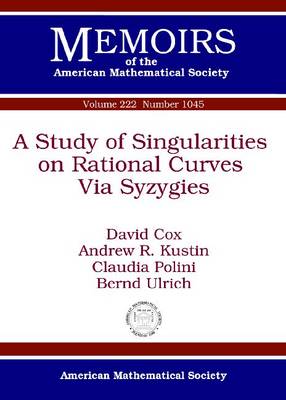Memoirs of the American Mathematical Society
1 total work
A Study of Singularities on Rational Curves Via Syzygies
by David Cox, Andrew R. Kustin, Claudia Polini, and Bernd Ulrich
Published 15 May 2013
Consider a rational projective curve C of degree d over an algebraically closed field kk. There are n homogeneous forms g1,...,gn of degree d in B=kk[x,y] which parameterise C in a birational, base point free, manner. The authors study the singularities of C by studying a Hilbert-Burch matrix for the row vector [g1,...,gn]. In the ""General Lemma"" the authors use the generalised row ideals of to identify the singular points on C, their multiplicities, the number of branches at each singular point, and the multiplicity of each branch.
Let p be a singular point on the parameterised planar curve C which corresponds to a generalised zero of . In the ""Triple Lemma"" the authors give a matrix ' whose maximal minors parameterise the closure, in P2, of the blow-up at p of C in a neighbourhood of p. The authors apply the General Lemma to ' in order to learn about the singularities of C in the first neighbourhood of p. If C has even degree d=2c and the multiplicity of C at p is equal to c, then he applies the Triple Lemma again to learn about the singularities of C in the second neighbourhood of p.
Consider rational plane curves C of even degree d=2c. The authors classify curves according to the configuration of multiplicity c singularities on or infinitely near C. There are 7 possible configurations of such singularities. They classify the Hilbert-Burch matrix which corresponds to each configuration. The study of multiplicity c singularities on, or infinitely near, a fixed rational plane curve C of degree 2c is equivalent to the study of the scheme of generalised zeros of the fixed balanced Hilbert-Burch matrix for a parameterisation of C
Let p be a singular point on the parameterised planar curve C which corresponds to a generalised zero of . In the ""Triple Lemma"" the authors give a matrix ' whose maximal minors parameterise the closure, in P2, of the blow-up at p of C in a neighbourhood of p. The authors apply the General Lemma to ' in order to learn about the singularities of C in the first neighbourhood of p. If C has even degree d=2c and the multiplicity of C at p is equal to c, then he applies the Triple Lemma again to learn about the singularities of C in the second neighbourhood of p.
Consider rational plane curves C of even degree d=2c. The authors classify curves according to the configuration of multiplicity c singularities on or infinitely near C. There are 7 possible configurations of such singularities. They classify the Hilbert-Burch matrix which corresponds to each configuration. The study of multiplicity c singularities on, or infinitely near, a fixed rational plane curve C of degree 2c is equivalent to the study of the scheme of generalised zeros of the fixed balanced Hilbert-Burch matrix for a parameterisation of C
